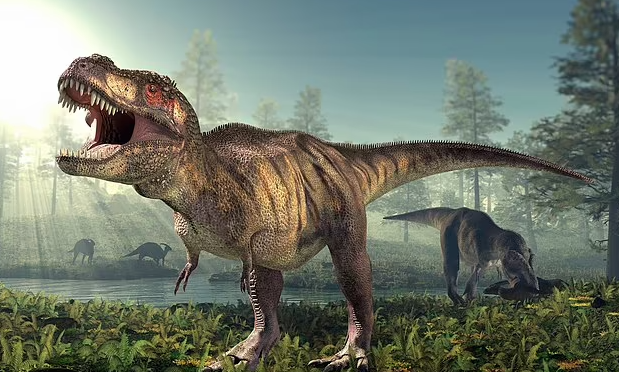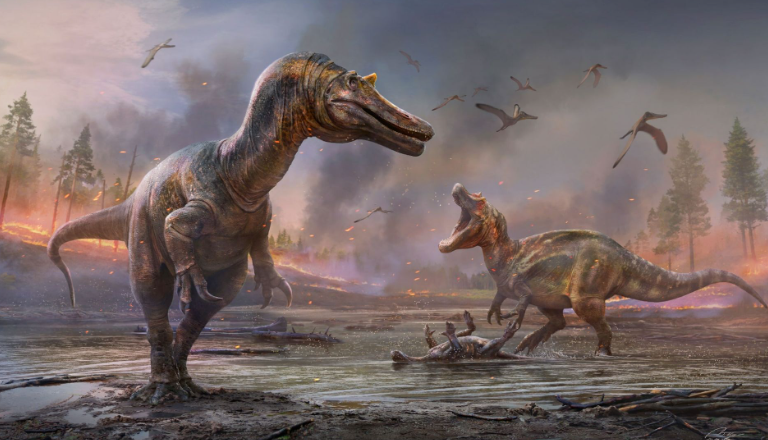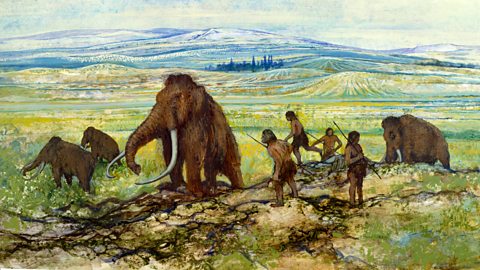Dinosaurs and humans never coexisted as there is a significant time gap of millions of years between their existence. The dinosaurs emerged during the Triassic Period of the Mesozoic Era, but they went extinct approximately 66 million years ago. On the other hand, the earliest form of modern humans, Homo sapiens, appeared around 315,000 years ago, which is at least 65 million years after the last dinosaurs roamed the Earth.
For more intriguing details about dinosaurs and humans and the reasons behind their lack of intersection, continue reading…
Please keep in mind that, unless stated otherwise, the term “dinosaur” used on this page refers to dinosaurs that are not birds, commonly known as non-avian dinosaurs.
MYA represents the measurement of time in millions of years ago.
The avian dinosaurs, also known as birds, were the sole survivors of the Cretaceous-Paleogene Extinction Event, which occurred approximately 66 million years ago.

Although it is technically accurate to state that humans coexisted with dinosaurs due to the existence of birds, it can be misleading because people generally associate dinosaurs with large creatures like T. rex or Apatosaurus.
These colossal creatures, along with all other non-avian dinosaur species, became extinct during the Cretaceous-Paleogene Extinction Event.
So, disregard what you’ve seen in “The Flintstones” or movies; humans, not even those in the Stone Age, never shared the Earth with dinosaurs!
Nevertheless, many scientists believe that the earliest primates, which were small insect-eating animals, did inhabit the same era as dinosaurs towards the end of the Cretaceous Period.
If you’re intrigued by more captivating details about dinosaurs and early humans, keep reading…
For information about early humans, you can explore these pages:
- When Did Humans First Appear?
- Human Evolution Timeline
Dinosaurs

Dinosaurs were an extraordinarily successful group of creatures that thrived for approximately 167 million years during the Mesozoic Era.
If you’re interested in learning more about dinosaurs, you can explore the Dinosaur Facts page.
Throughout their extensive existence, dinosaurs displayed a remarkable range and incredible diversity. They varied greatly in size, from the colossal Argentinosaurus huinculenis, which holds the title of the largest discovered dinosaur, measuring 130 feet in length and weighing 106.3 tons, to the diminutive Epidexipteryx hui, a mere 25 centimeters in size.
Whether large or small, herbivorous or carnivorous, dinosaurs dominated terrestrial habitats, occupying nearly every ecological niche.
However, it’s important to note that dinosaurs did not reign over the entire planet. They never inhabited the seas nor developed the ability to fly. (Creatures like plesiosaurs, mosasaurs, and pterosaurs were not considered dinosaurs.)
When Did Dinosaurs Live?

The Mesozoic Era, also known as the “Age of Reptiles,” spanned from approximately 252 million to 66 million years ago. It can be divided into three distinct periods:
- Triassic Period (252 million to 200 million years ago): The Triassic Period marked a period of recovery after a severe mass extinction event. It was towards the end of this period that dinosaurs first emerged. Some notable dinosaur species from this time include Chindesaurus and Lycorhinus.
- Jurassic Period (200 million to 145 million years ago): Between the Triassic and Jurassic periods, Earth experienced another mass extinction event, resulting in the demise of many of the early dinosaur competitors. This allowed dinosaurs to quickly rise to dominance on land. Well-known dinosaurs from the Jurassic Period include Diplodocus, Stegosaurus, and Allosaurus.
- Cretaceous Period (145 million to 65 million years ago): The Cretaceous Period saw a peak in dinosaur diversity. Popular dinosaurs from this time include Triceratops, Velociraptor, and the iconic Tyrannosaurus Rex, also known as T. Rex.
The First Dinosaurs

Dinosaurs, reptiles that originated from small, two-legged creatures, thrived during the Triassic era. They belong to a group of reptiles called archosaurs, which managed to survive the most catastrophic extinction event in history, known as the Permian-Triassic extinction event.
Scientists believe that this mass extinction was triggered by extensive volcanic eruptions. Initially, dinosaurs were relatively small in size and were vastly outnumbered by various prehistoric creatures, including early mammal ancestors and other reptilian groups.
Despite the odds, early dinosaurs managed to survive and gradually adapted to different habitats as climate conditions changed. However, it was during the Jurassic period, following another extinction event called the Triassic-Jurassic Extinction Event, that dinosaurs rose to become the dominant land animals.
Our understanding of dinosaurs heavily relies on fossil evidence, which is millions of years old. This evidence includes dinosaur bones and trace fossils like footprints. However, the fossil record is incomplete, and our knowledge of prehistoric life continues to expand as we uncover more discoveries.
The Cretaceous-Paleogene Extinction Event And The End Of The Dinosaurs

Approximately 66 million years ago, the era of dinosaurs reached its culmination. The catastrophic incident known as the Cretaceous-Paleogene extinction event marked the demise of these magnificent creatures, alongside various other beings like pterosaurs and ammonites. Scientists hypothesize that this cataclysmic event was instigated by the impact of a massive asteroid colliding with our planet.
Did Early Humans Live With Dinosaurs?
Around 300,000 years ago, a remarkable species known as Homo sapiens emerged, marking the advent of modern humans. This significant development occurred long after the dinosaurs vanished from the Earth’s surface, millions of years prior.
Our earliest human ancestors are believed to have originated in Africa, where they thrived before venturing into what we now recognize as Europe and Asia. Gradually, they dispersed throughout the globe, ultimately populating diverse corners of the world.
What Is A Human?
Humans, scientifically known as Homo sapiens, belong to the Homo genus, which is a subset of the Hominidae family—a larger family consisting of great apes. Among the primates, which encompass monkeys and apes, humans hold the highest population and prevalence.
Hominidae stands as one of the sixteen families found within the Primate order. It is worth noting that early representatives of the Homo genus, such as Homo habilis and Homo rudolfensis, thrived approximately two million years ago.
Did Early Man Live With Dinosaurs?
Approximately 2.8 million years ago, a new type of Homo genus emerged, marking the arrival of our early human ancestors. It’s worth noting that this evolutionary milestone occurred well after the demise of the mighty dinosaurs.
The Great Ape Family, Hominidae
Hominids, which belong to the great ape family called Hominidae, are referred to as members of this group. Within the Hominidae family, there are eight different species, with humans being one of them.
The remaining seven hominid species include three types of orangutans (Sumatran, Bornean, and Tapanuli), two species of gorillas (eastern and western), as well as the chimpanzee and the bonobo, both of which belong to the genus Pan.
As for the question of whether hominids coexisted with dinosaurs, the answer is no. Hominids did not inhabit the Earth at the same time as dinosaurs. The earliest hominids emerged approximately 17 million years ago, which is about 49 million years after the extinction of the last dinosaurs.
Primates

The Hominidae family is a part of a larger animal group known as the Primates, which encompasses apes, monkeys, lemurs, galagos, and tarsiers.
Primates originated from animals that lived in trees, known as arboreal creatures. Many characteristics of primates can be attributed to their ancestral tree-dwelling lifestyle.
Distinctive traits of primates include large brains, excellent eyesight, binocular vision, opposable thumbs, and flexible shoulder joints. These traits are highly advantageous for animals that climb trees.
For more information on primates, you can explore the following resource: “Primates: The Ultimate Guide.”
Did Primates Coexist with Dinosaurs?
Although there is limited evidence of primate fossils from the Cretaceous Period, many paleontologists believe that primates potentially lived alongside dinosaurs during the Late Cretaceous Period, if not even earlier.
Early primates are hypothesized to have evolved from small, nocturnal, insectivorous creatures that might have resembled small rodents.
Characteristics of Humans

Humans are social creatures who exhibit remarkable traits such as tool usage, the development of intricate cultures and societies, the establishment of leadership structures, the practice of rituals, and the formation of values. Communication among humans is facilitated by the employment of sophisticated and highly evolved languages.
In terms of physical attributes, humans possess large brains capable of complex thinking. They are characterized by their bipedal nature, walking upright on two legs. Humans belong to the mammalian class, indicating that they give birth to live offspring, maintain a warm-blooded metabolism, and have hair. In contrast, dinosaurs, which were reptiles, laid eggs in nests.
The Term “Human”
The term used to denote the modern human species, Homo sapiens, originated from the Latin words meaning “wise man.” This name was coined by Carl Linnaeus in 1758, who also developed the taxonomy system used to classify living organisms. As additional human species were discovered, each one was subsequently added to the existing list.
Did Humans Live With Dinosaurs: Conclusion
Throughout the course of history, there has been a considerable gap of more than 65 million years between the existence of dinosaurs and the advent of human beings. Even in the early stages of human development, dinosaurs were not contemporaneous with our ancestors, although researchers speculate that the earliest primates might have shared the Earth with these magnificent creatures.
Looking ahead, there is a possibility that advanced technology resembling that depicted in Jurassic Park could emerge, allowing us to revive dinosaurs and potentially coexist with them in the future. However, it is important to note that humans have never actually shared an era with dinosaurs in the past.